Overview
As times moved from the unification of the Northern and Southern Dynasties to the Onin War and the political upheaval of the Meio period, dancing Nembutsu, the spread of Buddhism, became a popular folk belief of the common people, accompanied by entertainment, and became associated with the Ura Bon festival. It also merged with the Furyu, a flamboyant aspect that caught people by surprise, giving birth to the Bon dance Furyu Odori. This is the origin of Bon Odori.
During this period
This period.
After a period of stability, the Onin War and the Meio political upheaval brought a period of warfare and chaos.
1333 – 1500s
1333: New administration of Kenmu
1336 Opening of the Muromachi Shogunate
Overview
The 16th century was the “age of dance,” when dances with flamboyant flair were held throughout Japan, including Bon Odori. During this period, the main stage for Bon Dancing shifted to the capital of Kyoto and then to the provinces. In Kyoto, the townspeople who had gained economic power played a leading role and became the main actors of Bon Dancing.
This period
.
In Kyoto, the Hosokawa family’s grasp on power and intra-family strife continued. Meanwhile, the provinces were in the midst of the Sengoku period. After Nobunaga Oda conquered Kyoto and took control of the capital, the Honnoji Incident led to the Toyotomi administration, and the Sengoku period turned into the Azuchi-Momoyama period.
1508-31: Takakuni Hosokawa seizes control of the Kinai region.
1532-48: Harumoto Hosokawa seizes control of the Kinai region.
1549-68: Nagayoshi Miyoshi seizes control of the Kinai region
1546: The Battle of Kawagoe (Ujiyasu Hojo defeated the Kanto governor and the Kamakura shogunate to become the supreme ruler of the Kanto region)
1555: Battle of Itsukushima (Motonari Mori became the ruler of the Chugoku region)
1560: Battle of Okehazama
1561: Battle of Kawanakajima
<Azuchi-Momoyama Period>
1568-83 Oda administration
1585-1603 Toyotomi administration
Basic Information
Population: Approximately 12 millionAttribute types: Nobles, monks, warriors, peasants, and unrelated persons. More than 80% are peasants. Townspeople who make their living in commerce and industry are also emerging in local cities.
Longevity: Around 35 years old.
Famine and disaster conditions: Famine, plague, and disaster every 3-5 years. Devastation by war
Media of transmission: Scripts were used only by aristocrats, warriors, and village rulers, so it was handed down mainly by oral tradition
Domain system: Domination of territory by the local masters and warring feudal lords.
Common people’s clothing: Simple kimonos, increased use of cotton and dyeing
Food of the common people: Japanese millet, millet, and vegetables
Dwelling of the common people: Thatched dwellings with floor plans
Occasions for entertainment/Bon Dances of the common people: Samurai under the control of townspeople and feudal lords spread the traditional dances in various cities. In the Kinai region, some people in rural areas also began to enjoy the “furyu” style of dancing. Even in the farming villages, “fairs” were set up and became lively.
Religion
Nenbutsu Odori (Dance of the Nembutsu) Eventually, the Nembutsu performing arts became the mother of many other performing arts.Bon Dancing: What Happened Around This Time
“A Century of Dance”
On the performing arts side, dancing became the “main” part of “Fu-ryu”.
The great breakthrough of Fu-ryu Odori: Fu-ryu umbrellas, drums, and conductors.
Furyu Odori of Kyoto’s Bon Festival “Records of the Diary of an Expert”
.
A public diary of Sanetaka, About Sanjonishi Sanetaka
About KototsuguAbout Kototsugu Yamashina.
Diary of Tsuneoki Odate
Diary of an aristocrat. Many descriptions of Bon festival dances in Kyoto.
| Literary name | author | Deadline | AD | Content |
|---|---|---|---|---|
| Msamotoko tabi hikitsuke | Kujo Masamoto | First year of Bun Kamikame | 1501 ~ 4 | Until the 15th, the peasants of Iriyamada Shika Village (Funabuchi / Shobu / Oki / Domaru Village) hold a wind -style Buddha. |
| Sanetaka koki | Sajonishi Sanetaka | July 16th, 2nd year | 1505 | Dance in the evening, speech, and ghosts, |
| Sanetaka koki | Sajonishi Sanetaka | July 17th, 2nd year | 1505 | Dance in the evening, excess |
| Sanetaka koki | Sajonishi Sanetaka | July 18, 28 | 1505 | Zokyo Naka Dance, Bell Drum Deaf Fighting Satisfied Gansei Involvable Involvable |
| Sanetaka koki | Sajonishi Sanetaka | July 2nd, 2nd year | 1505 | At night, the night gesture, the paddy temple at first glance (abbreviated) |
| Tokitsugukyoki | Yamashina Tokitsugu | #VALUE! | 1532 | Wind flow, each round weather F except for the skin until 8 o'clock. Sizzling |
| Kanginshu | Energy 15 years | 1518 | Muromachi Koika is summarized/After that, it became a bon dance song. | |
| Gohosshoji Kanpakuki | Konoe Naomichi | July 23rd, July 2nd, Kyoku | 1529 | The author Naodori Konoe's "Sale / Nishioji Pu Riu (Wind Style)" Tour |
| Odate joyonikki | Odate Naouji | Astronomy July 14, 1991 | 1540 | To the young kimi, please give you a good idea |
| Rokuonnikki | Successive Rokuon -in owner | Astronomy July 16th, 1997 | 1540 | There is a Johokigawa -dono style |
| Tokitsugukyoki | Yamashina Tokitsugu | Astronomy July 14th | 1544 | Today's Kyoto Chu -style Shoguni -no -child stop, and so on |
| Tokitsugukyoki | Yamashina Tokitsugu | Eiroku July 20th | 1559 | To the head of the temple at the present day, the style of rewaring of the style |
| Tokitsugukyoki | Yamashina Tokitsugu | Eiroku July 16th, 6th | 1565 | Horikawa Emori takes a request, and the Omita -cho is 56 people, and the beats below |
| Tokitsugukyoki | Yamashina Tokitsugu | 4th year of Tensho | 1576 | Yuki Yukita, Tonight, Ichifu -style gate, Mandarin |
| Tokitsugukyoki | Yamashina Tokitsugu | Tensho, July 19, 16 | 1588 | Yunma Yuma Ariyuki Ariyuki Ariyuki |
Rakuchu Rakugai-zu Byobu
Rekihaku Ko-hon, dated 1525-36 Color on paper, Rakuchu-Rakugai-zu, left screen (Rekihaku Ko-hon) Lower left: Unauthorized reproduction prohibited, owned by National Museum of Japanese History, permission obtained[/caption].Periodical background
Hosokawa-affiliated samurai residences were the political focus of the painting.
The Yanagihara Palace under construction – Norimaya – Hosokawa residence is the central line.
Hogyoji Temple and Momoshi Bridge are at the same location as today.
The dancers dance in a circle, with those around them bending over at the waist and using surizasara.
They wear umbrellas on their heads.
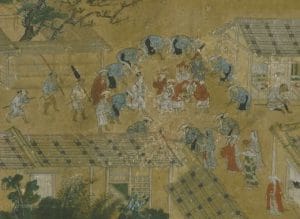
Color on paper, left screen from Rekihaku Ko-hon Part of “Fu-ryu Odori” (dance), reproduction without permission is prohibited, owned by National Museum of Japanese History, permission obtained
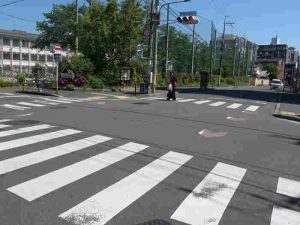
Around the current Ichijocho Street street street
Tohaku copy, dated 1539 or later
.
Furyu Odori is performed at Ichijo Nishinotoin Tsuji
Left screen, 6th fan.
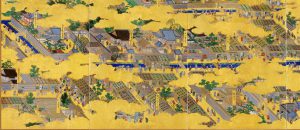
Rakuchu Rakugai-zu Byobu, copy from the Tokyo National Museum, reproduction ” Reproduction from the University of Tokyo” Permission verified Lower left of left screen
Period Background
Reconstruction of the Imadegawa Palace on the site of the Hana no Gosho (Yoshiharu built by Harumoto Hosokawa)
[The 6th Muromachi-dono] (1542-1552)
Leap March: Muromachi-den rebuilt on the former site of Kitakoji Muromachi. Yoshiharu Ashikaga moves from Shokokuji Temple. (now Doshisha).
Named after the fact that the Muromachi side (= west side) of the former Hana-no-Gosho was unusable because it was built up, and the Imadegawa Dori (north-south street corresponding to today’s Karasuma Dori) side (= east side) was taken as the front.
Like the Rekihaku Ko-hon, it is ringed, and those around it use surizasara.
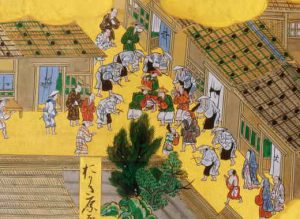
Rakuchu Rakugai-zu Byobu, copy from the Tokyo National Museum, reproduction ” Reproduction from the University of Tokyo, permission verified, left-hand screen, part of the “Furyu Odori” dance (at Ichijo Nishinotoin Tsuji)
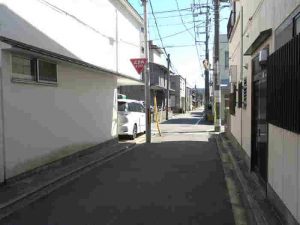
Around the current Ichijo Nishinotoin no Tsuji
Uesugi Hon, landscape date 1547-61
.
Historical Background
Chokei’s successor Yoshitsugu Miyoshi and the three Miyoshi warriors run amok and attack the Buei camp
5.18 Stop at Chou-i Chion-ji, Yoshitsugu Kawado, and Hisahide Shokoku-ji Jotokuin (Kototsugu)
5.19. 19. Siege of Buei camp, killing the Shogun
The “Yoshiteru-Miyoshi system” collapses, and the Miyoshi Sanninshu take over.
The Furyu Odori dance is held on the west side of the 2nd fan of the right hand screen.
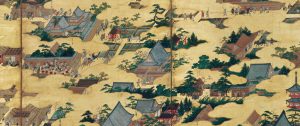
Unauthorized reproduction prohibited right screen from Uesugi’s Rakuchu Rakugai-zu, Yonezawa City. Uesugi Museum, Yonezawa, Japan
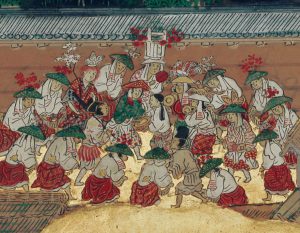
The right-hand screen from Uesugi’s Rakuchu-Rakugai-zu folding screen with two fan-shaped dances Reproduction by permission of the Uesugi Museum, Yonezawa, Japan
Image of dance connected to modern Bon Odori dance
Both the Rekihaku Ko-hon and Tohaku copy depict a person in the center wearing a red bear (gaudy colored hat) and glittering clothes leading the music with musical instruments (drums, etc.), while the people on the outside are stamping their feet. The movements of the people around them are thought to be in the form of stepping their feet firmly. This movement may be related to the magical tapping of the feet called “hembai,” or a derivative movement (e.g., shiko in sumo wrestling). The foot-stamping movement is also often seen in the Bon Odori dance of the Fu-ryu Taiko Odori style that still remains today.
The Nishino-honkokuji Bon dance on Tanegashima Island is similar to the dance depicted in the Rakuchu Rakugaizu. The person in the middle wears a Furyu umbrella and the people around him dance (the dance still retains some hembai dance steps), and there is no use of surizasaara, but the similarities between the two are quite striking.
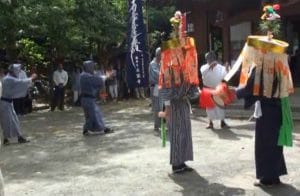 Nishino-honkokuji Bon Dance on Tanegashima Island, which retains its old form[/ caption]
Nishino-honkokuji Bon Dance on Tanegashima Island, which retains its old form[/ caption]
Furyu Odori of these days
inferred to have been present.
2006 Folk Performing Arts Society of Japan
Lecturer: Mr. Yukinobu Ueki Theme: [ Current Situation and Issues in the Study of Fu-ryu Odori ] Examples from Shiga and Kyoto
A. The dancers play musical instruments while dancing.
B. Dances in which the dancers use kouta (small songs in the form of kumi-uta) as the dance song, but the dancers are mainly chudori (middle dancers) or dancers of that lineage who dance while wearing waist drum.
Use Kouta in the form of Kumiuta as the dance song. In the part of the song where the Soba Odori dances, dancers with two different types of drums and Nakaodori that is made up of dancers become Hayashikata (musical accompaniment). In Fushi-byoshi, Nakaodori become the dancers and its dance is the main part
Use kouta in the form of kumi-uta as song to dance. The dancers play the drums, tsutsumi, and other dancers, and the nakadori dancers play the ondo (the musical accompaniment) for the part of the song danced by the side dancers, and the nakadori dancers are the main dancers in the section of the “besshiko”.
D. D. An abbreviated form of B, in which a small group of dancers wearing waist drum costumes and holding or lowering small drums dance with the direction of a Shimbochi who picks up bamboos.
E. A shortened form of B. E. Dances that consist of musicians and dancers, and are performed mainly to enjoy the dance song as a song.
The “*Furyu Odori” is a type of dance that does not have a song as in (A) above.
Furyu Odori] is divided into two types: (A) those that do not have a song, Hyoushi-mono and (B) those that share a song, Furyu-odori.
The dancers in Youko costumes play the main part of “taikoodori”and
the “Taiko-odori”, in which the dancers play multiple percussion instruments such as drums.
Kouta Odori, in which the dancers mainly enjoy dancing songs and dance gently along the songs “koutaodori”.
Independence of Bon Dancing
The appearance of “Bon Dancing” in the true sense of the word.
The main actor is the “townspeople. They are called “Koso Choshu. They are people with a strong elitist flavor, and not all ordinary citizens are participants.
The townspeople formed “groups” in each town and danced with each other.
The fact that people from all walks of life, including warriors and aristocrats, danced together, centering on the townspeople, is a characteristic feature of this period.
The dance is considered to have a strong aspect of “kake-odori,” which means “to go around streets and residences and dance with other dancers.
The religious nature of the early period weakened, and the entertainment aspect of the dance increased.
Appearance of Bon (Furyu) dance in the region
In the ” Masamoto’s Travel Guide,” a record of Masamoto Kujo’s visit to Hinenoso (present-day Izumisano City) to administer the manor, the manor’s traditional dance is described. Masamoto Kujo was originally the owner of Hineno-so, but at the time, he was in dispute with the guardian Negoroji over the right to collect annual tribute from the manor, and he went there to secure the land. There were constant disputes in the village, with villagers fleeing temporarily, and fights involving casualties. Despite this, the people of the manor held “Nenbutsu Fu-ryu,” a Buddhist prayer service during the Bon Festival, and impressed Masamoto by saying, “It is as good as anything in the capital.
The village people also enjoyed the “Nenbutsu Fu-ryu” Bon Festival, and Masamoto was impressed by their performance, saying, “It is no less than the one in the capital.
Visiting Hinenosho today, “Bon Dancing in History”
| Literary name | author | era name | AD | Content |
|---|---|---|---|---|
| Msamotoko Tabihiktsuke | Kujo Masamoto | Bunki1 | 1501`4 | On the 13th day, this night, the people of the village of Funa Yuan have come to the court of the Hall of the people, and to the court of the Temple of the Temple of the Buddha, and in the future, the people of the field and the house of the people can be more than the cause of the rise, into the place where they can be seen, each can make, the cloud of wind, the cloud of words are not ashamed of the ability of the people, the article; so the following is the actual. I'm afraid that the people who have the job, the pleasure of the people, a hundred bolt to pay the dispatch of wine straight cloud;, it is not possible. |
There is a record of the Furyu dance by the feudal lords of the Sengoku period. Prominent historical figures such as Nobunaga Oda and Ujimasa Imagawa are also recorded as enjoying the dance.
It is evident that the culture of Kyoto spread to the provinces.
Nobunaga also danced, Bon dances of great people
.
| Literary name | author | era name | AD | Content |
|---|---|---|---|---|
| Shinchokoki | Ota gyuichi | Kochu2,7,18 | 1556 | On July 18, the red ogre Hirate Uchirenshu, the black ogre Asai Bichu-mori, and the hungry ogre Takigawa Sakonshu were in attendance, and they played the kotsuzumi and performed the female dance. In Tsushima, he performed a dance at the Hotta Dokutei, and then returned to Kiyosu. In Tsushima, the elderly people of five villages returned the dances, and everyone returned home with tears in their eyes, forgetting the hardships of the blazing sun. |
| Koutei Matsudairaki | unknown | Eiroku10 | 1567 | In the seventh month, the Suruga Province was filled with the joys of the fengryu style, and all the people danced the dance. `In June of the 11th year of the Era of Eiroku, the dance was performed again, and Ujizane played the big drum. |
| Miyoshiki | unknown | Tensho6,7,16 | 1578 | The thing of the style: In order to have the dance of the lord of Sogo MasayMasayasu, a temporary house was built and the seats were placed in an ordinary manner. |
History of Bon Dance
- 0-1 The History of Uraabon
- 0-2 Ancient Japanese customs of the common people (not documented)
- 0-3 Late Heian Period, just before the birth of Bon Dancing
- 1.Kamakura Period Birth of Dancing Nembutsu
- 10.Heisei Reiwa: From Stagnation to the Birth of a New Axis
- 2.Birth of Bon no Furyu Odori (Bon Dance) in the mid-Muromachi Period
- 3.Late Muromachi – Sengoku – Azuchi-Momoyama Rise of Fuuryu Odori and Regional Expansion
- 4.Early Edo Period Establishment of Bon Dancing
- 5.Mid to Late Edo Period Bon Dancing takes root and matures
- 6.Meiji: A Turning Point for Bon Dancing
- 7.Taisho Era – Early Showa Era Revival of Bon Dancing
- 8.Before and After the War Wartime Response, Suspension and Resumption
- 9.Late mid-Showa period Nationwide expansion of Ondo and Minyo (folk songs)
